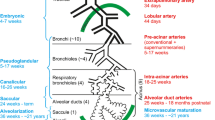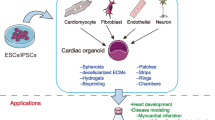Summary
-
1.
In stages 5 and 6 ofHamburger andHamilton, the presumptive heart primordia of both sides, placed in contact, Fig. 1, originate two hearts in many cases instead of joining and originating a unique heart, as happens during normogenesis.
-
2.
The two hearts are independent and are found to be very close in the same pericardial cavity, Figs. 7 and 8.
-
3.
The heart formed, from the primordium left “in situ”, is a complete and normal heart, Figs. 7 and 8.
-
4.
The heart formed from the transplant is much smaller and consists of a bulb, ventricle, and in some cases atrium, but its curvatures are typical and normal, Figs. 7 and 8.
-
5.
The heart formed of the transplant organizes itself in contact with a small foregut formed from the endoderm of the transplant, Figs. 4 and 9.
-
6.
The endoderm ist not only important in order for the P.H.M. to begin its differentiation in a heart direction but also organizes the P.H.M in such a way that the result is not only heart tissue but a heart, i.e. an organ with typical form and structure.
Similar content being viewed by others
Bibliography
Amprino, R., andM. Camosco: On the role of the “apical ridge” in the development of the chick embryo limb bud. Acta. anat. (Basel)38, 260–288 (1959).
Grobstein, C.: Interactive processes in cytodifferentiation. J. cell. comp. Physiol.60, 35–48 (1962).
Haan, R. L. de: Morphogenetic movements in cardiogenesis. A. R. Director Department Embryol. Carnegie Inst. Washington57, 322–325 (1957/58).
—: Cell migration and morphogenetic movements. The Chemical Basis of Development, edit. byWilliam D. McElroy andBently Class, p. 339–377. Baltimore: Johns Hopkins Press (1958).
—: Morphogenetic movements of the precardiac mesoderm. A. R. Director Department Embryol. Carnegie Inst. Washington60, 419–424 (1960/61).
Hamburger, V., andH. L. Hamilton: A series of normal stages in the development of the chick embryo. J. Morph.88, 49–92 (1951).
Millaire, J.: Histochemical aspects of limb morphogenesis in vertebrates. In: Advances in morphogenesis, vol.2, p. 183–208. New York: University Press 1962.
Moscona, A. A.: Synthesis of tissues in vitro from cells in suspension: cellular and environmental factors. Biological interactions in normal and neoplasmic growth. Henri Ford Hospital international symposium, p. 113–126. Boston: Little, Brown & Co. 1961.
Patten, B. M., andT. C. Kramer: The initiation of contraction in the embryonic chick heart. Amer. J. Anat.53, 349–375 (1933).
Rawles, M. E.: The heart forming areas of the early chick blastoderm. Physiol. Zool.16, 22–45 (1943).
Saunders jr.,J. W., M. T. Gasseling, andM. D. Gfeller: Interactions of ectoderm and mesoderm in the origin of axial relationship in the wing of the fowl. J. exp. Zool.137, 39–74 (1958).
Weiss, P.: Cells and their environment, including other cells. Biological interactions in normal and neoplasic growth. Henri Ford, Hospital international symposium, p. 3–20. Boston: Little, Brown & Co. 1961.
Zwilling, E.: Interaction between ectoderm and mesoderm in duck chicken limb bud chimaeras. J. exp. Zool.142, 521–532 (1959).
Author information
Authors and Affiliations
Rights and permissions
About this article
Cite this article
Llorca, F.O. What are the factors which lead to the fusion of the two heart primordia ? An experimental analysis. W. Roux' Archiv f. Entwicklungsmechanik 155, 437–450 (1964). https://doi.org/10.1007/BF00577652
Received:
Issue Date:
DOI: https://doi.org/10.1007/BF00577652




